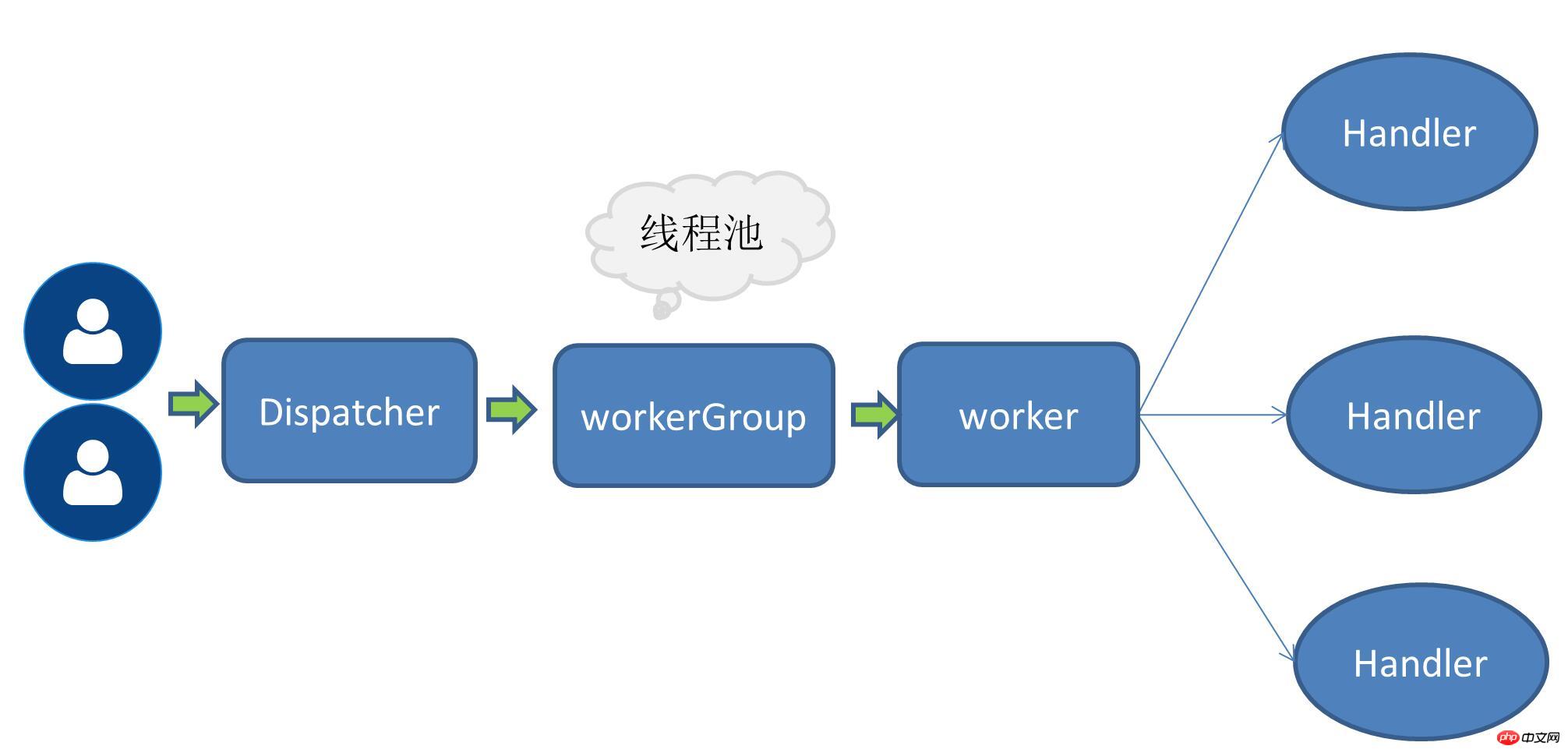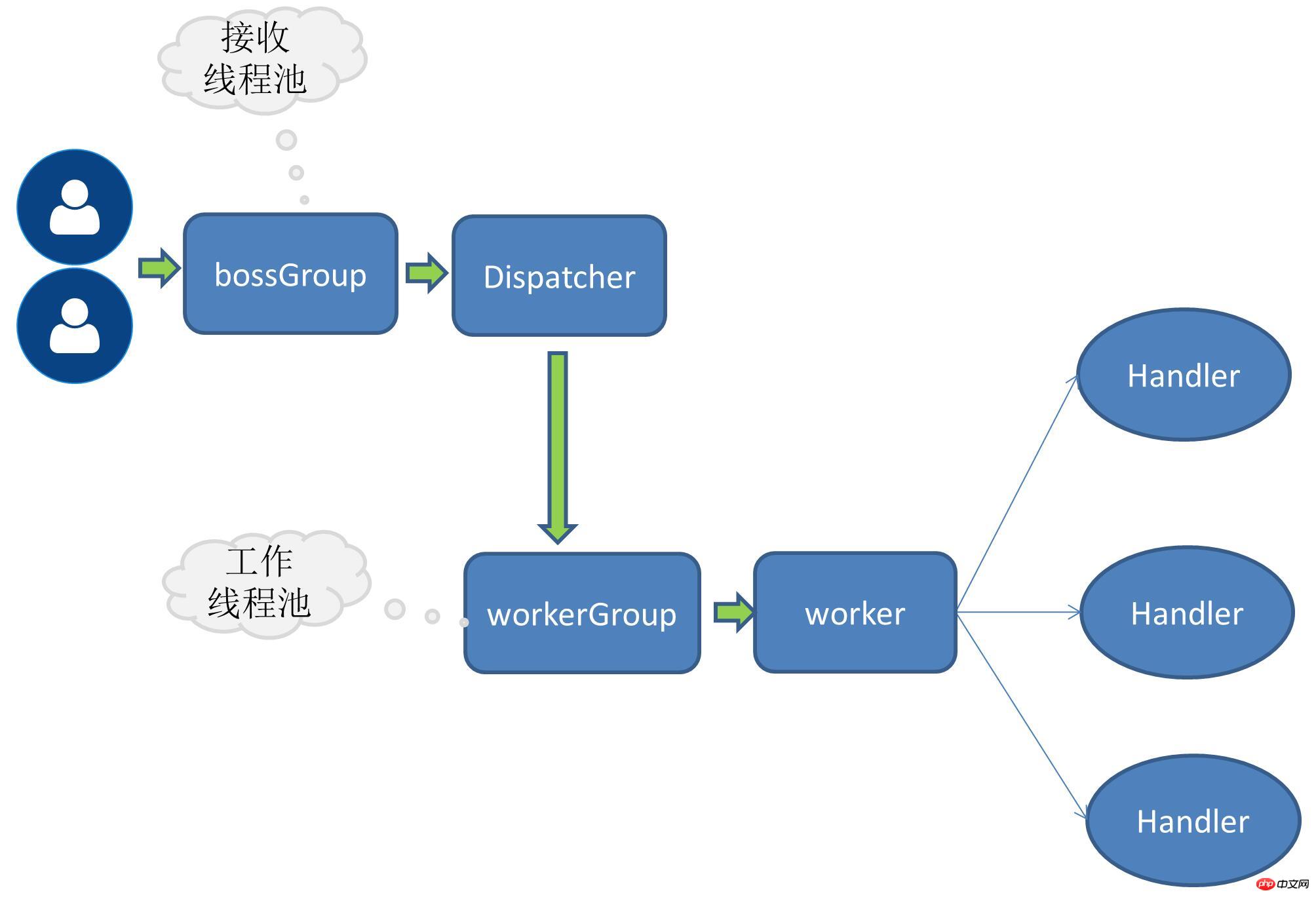Netty 線程模型的實例詳解
Netty 執行緒模型
Netty的執行緒模型主要是基於React,因為考慮到應用程式場景的不同所以演化出多種版本。
單執行緒模式
即接收服務請求以及執行IO操作都由一個執行緒來完成,由於採用的是IO多路復用這類無阻塞IO操作,所以在請求量不大的情況下單執行緒模式也是可以解決一部分場景問題的。

單接收多工作執行緒模式
當請求量增加後,原有的一個執行緒處理所有IO運算變得越來越無法支撐對應的效能指標,所以提到了一個工作線程池的概念,此時接收服務請求還是一個線程,接收請求的線程收到請求後會委託給後面的工作線程池,從線程池中取得一個線程去執行用戶請求。

多接收多工作執行緒模式
當請求量進一步增大後,單一的接收服務請求的執行緒無法處理所有客戶端的連接,所以將接收服務請求的也擴展成執行緒池,由多個執行緒同時負責接收客戶端的連線。

RPC 業務執行緒
上面提到的都是Netty自身的執行緒模型,伴隨著請求量的成長而不斷發展出來的最佳化策略。而RPC請求對應用系統來講最主要還是業務邏輯的處理,而這類業務有可能是計算密集型的也有可以是IO密集型,像大多數應用都伴隨著數據庫操作,redis或者是連接其它的網路服務等。如果業務請求中有這類耗時的IO操作,建議將處理業務請求的任務指派給獨立的執行緒池,否則可能會阻塞netty自身的執行緒。

接收請求執行緒與工作執行緒分工
#接收請求執行緒主要負責建立鏈路,然後將請求委派給工作線程
工作線程負責編碼解碼讀取IO等操作
public void bind(ServiceConfig serviceConfig) {EventLoopGroup bossGroup = new NioEventLoopGroup();EventLoopGroup workerGroup = new NioEventLoopGroup();try {ServerBootstrap bootstrap = new ServerBootstrap();
bootstrap.group(bossGroup, workerGroup)
.channel(NioServerSocketChannel.class)
.childHandler(this.rpcServerInitializer)
.childOption(ChannelOption.SO_KEEPALIVE,true)
;try {ChannelFuture channelFuture = bootstrap.bind(serviceConfig.getHost(),serviceConfig.getPort()).sync();//...channelFuture.channel().closeFuture().sync();
} catch (InterruptedException e) {throw new RpcException(e);
}
}finally {
bossGroup.shutdownGracefully();
workerGroup.shutdownGracefully();
}
}boosGroup就是一組用來接收服務請求的增加業務線程只需要將handle的操作進一步委派給線程池即可,這裡為了擴展所以需要定義接口:定義線程池介面workerGroup就是一組具體負責IO操作的
public interface RpcThreadPool {Executor getExecutor(int threadSize,int queues);
}#參考了dubbo線程池
@Qualifier("fixedRpcThreadPool")@Componentpublic class FixedRpcThreadPool implements RpcThreadPool {private Executor executor;@Overridepublic Executor getExecutor(int threadSize,int queues) {if(null==executor) {synchronized (this) {if(null==executor) {
executor= new ThreadPoolExecutor(threadSize, threadSize, 0L, TimeUnit.MILLISECONDS,
queues == 0 ? new SynchronousQueue<Runnable>() :(queues < 0 ? new LinkedBlockingQueue<Runnable>(): new LinkedBlockingQueue<Runnable>(queues)),new RejectedExecutionHandler() {@Overridepublic void rejectedExecution(Runnable r, ThreadPoolExecutor executor) { //...}
});
}
}
}return executor;
}
}執行緒池工廠
###當有多個執行緒池實作時,透過執行緒池名稱來動態選擇執行緒池。 ######@Componentpublic class RpcThreadPoolFactory {@Autowiredprivate Map<String,RpcThreadPool> rpcThreadPoolMap;public RpcThreadPool getThreadPool(String threadPoolName){return this.rpcThreadPoolMap.get(threadPoolName);
}
}@Overrideprotected void channelRead0(ChannelHandlerContext channelHandlerContext, RpcRequest rpcRequest) {this.executor.execute(new Runnable() {@Overridepublic void run() {RpcInvoker rpcInvoker=RpcServerInvoker.this.buildInvokerChain(RpcServerInvoker.this);RpcResponse response=(RpcResponse) rpcInvoker.invoke(RpcServerInvoker.this.buildRpcInvocation(rpcRequest));
channelHandlerContext.writeAndFlush(response);
}
});
}以上是Netty 線程模型的實例詳解的詳細內容。更多資訊請關注PHP中文網其他相關文章!

熱AI工具

Undresser.AI Undress
人工智慧驅動的應用程序,用於創建逼真的裸體照片

AI Clothes Remover
用於從照片中去除衣服的線上人工智慧工具。

Undress AI Tool
免費脫衣圖片

Clothoff.io
AI脫衣器

Video Face Swap
使用我們完全免費的人工智慧換臉工具,輕鬆在任何影片中換臉!

熱門文章

熱工具

記事本++7.3.1
好用且免費的程式碼編輯器

SublimeText3漢化版
中文版,非常好用

禪工作室 13.0.1
強大的PHP整合開發環境

Dreamweaver CS6
視覺化網頁開發工具

SublimeText3 Mac版
神級程式碼編輯軟體(SublimeText3)
 如何評估Java框架商業支援的性價比
Jun 05, 2024 pm 05:25 PM
如何評估Java框架商業支援的性價比
Jun 05, 2024 pm 05:25 PM
評估Java框架商業支援的性價比涉及以下步驟:確定所需的保障等級和服務等級協定(SLA)保證。研究支持團隊的經驗和專業知識。考慮附加服務,如昇級、故障排除和效能最佳化。權衡商業支援成本與風險緩解和提高效率。
 PHP 框架的學習曲線與其他語言框架相比如何?
Jun 06, 2024 pm 12:41 PM
PHP 框架的學習曲線與其他語言框架相比如何?
Jun 06, 2024 pm 12:41 PM
PHP框架的學習曲線取決於語言熟練度、框架複雜性、文件品質和社群支援。與Python框架相比,PHP框架的學習曲線較高,而與Ruby框架相比,則較低。與Java框架相比,PHP框架的學習曲線中等,但入門時間較短。
 Java框架的效能比較
Jun 04, 2024 pm 03:56 PM
Java框架的效能比較
Jun 04, 2024 pm 03:56 PM
根據基準測試,對於小型、高效能應用程序,Quarkus(快速啟動、低記憶體)或Micronaut(TechEmpower優異)是理想選擇。 SpringBoot適用於大型、全端應用程序,但啟動時間和記憶體佔用稍慢。
 PHP 框架的輕量級選項如何影響應用程式效能?
Jun 06, 2024 am 10:53 AM
PHP 框架的輕量級選項如何影響應用程式效能?
Jun 06, 2024 am 10:53 AM
輕量級PHP框架透過小體積和低資源消耗提升應用程式效能。其特點包括:體積小,啟動快,記憶體佔用低提升響應速度和吞吐量,降低資源消耗實戰案例:SlimFramework創建RESTAPI,僅500KB,高響應性、高吞吐量
 golang框架文件最佳實踐
Jun 04, 2024 pm 05:00 PM
golang框架文件最佳實踐
Jun 04, 2024 pm 05:00 PM
編寫清晰全面的文件對於Golang框架至關重要。最佳實踐包括:遵循既定文件風格,例如Google的Go程式設計風格指南。使用清晰的組織結構,包括標題、子標題和列表,並提供導覽。提供全面且準確的信息,包括入門指南、API參考和概念。使用程式碼範例說明概念和使用方法。保持文件更新,追蹤變更並記錄新功能。提供支援和社群資源,例如GitHub問題和論壇。建立實際案例,如API文件。
 如何為不同的應用場景選擇最佳的golang框架
Jun 05, 2024 pm 04:05 PM
如何為不同的應用場景選擇最佳的golang框架
Jun 05, 2024 pm 04:05 PM
根據應用場景選擇最佳Go框架:考慮應用類型、語言特性、效能需求、生態系統。常見Go框架:Gin(Web應用)、Echo(Web服務)、Fiber(高吞吐量)、gorm(ORM)、fasthttp(速度)。實戰案例:建構RESTAPI(Fiber),與資料庫互動(gorm)。選擇框架:效能關鍵選fasthttp,靈活Web應用選Gin/Echo,資料庫互動選gorm。
 Java框架學習路線圖:不同領域中的最佳實踐
Jun 05, 2024 pm 08:53 PM
Java框架學習路線圖:不同領域中的最佳實踐
Jun 05, 2024 pm 08:53 PM
針對不同領域的Java框架學習路線圖:Web開發:SpringBoot和PlayFramework。持久層:Hibernate和JPA。服務端響應式程式設計:ReactorCore和SpringWebFlux。即時計算:ApacheStorm和ApacheSpark。雲端運算:AWSSDKforJava和GoogleCloudJava。
 Golang框架學習過程中常見的迷思有哪些?
Jun 05, 2024 pm 09:59 PM
Golang框架學習過程中常見的迷思有哪些?
Jun 05, 2024 pm 09:59 PM
Go框架學習的迷思有以下5種:過度依賴框架,限制彈性。不遵循框架約定,程式碼難以維護。使用過時庫,帶來安全和相容性問題。過度使用包,混淆程式碼結構。忽視錯誤處理,導致意外行為和崩潰。






